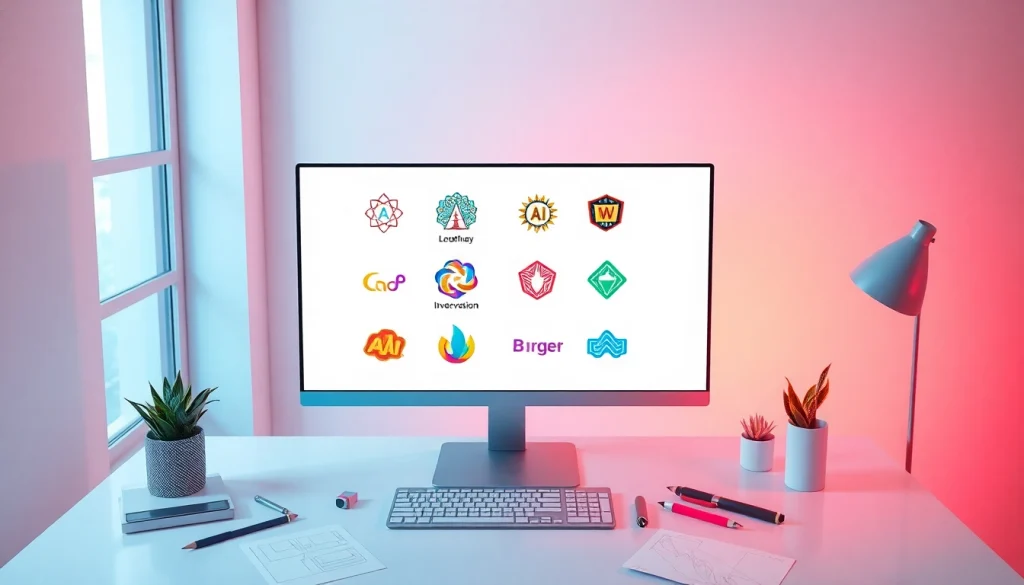Understanding Custom AI Logo Design
What is Custom AI Logo Design?
Custom AI logo design is an innovative approach to creating brand visuals using artificial intelligence technologies. Unlike traditional logo design, which often relies heavily on the skills of a graphic designer, AI logo design utilizes machine learning algorithms to generate logos based on specific inputs such as company name, preferred colors, symbols, and themes. These AI-driven tools analyze vast amounts of design data to produce unique logo options tailored to the brand’s identity, ensuring a blend of aesthetic appeal and professional quality. This process not only streamlines the design workflow but also significantly reduces the time and cost involved in logo creation.
Benefits of Using AI for Logo Creation
- Speed: AI can generate multiple logo options in just minutes, allowing businesses to review and select designs quickly.
- Cost-effective: AI tools typically offer more affordable options compared to hiring professional designers.
- Customization: Users can specify preferences, leading to designs that better align with their brand vision.
- Consistency: AI ensures that generated logos adhere to design principles and maintain a professional look.
- Accessibility: Many AI logo generators are available online, enabling businesses of all sizes—including startups and freelancers—to create customized logos without specialized design skills.
Key Features of Effective Logos
An effective logo is more than just a visually appealing graphic; it plays a crucial role in establishing brand identity. Key features of effective logos include:
- Memorability: A great logo should be easily remembered and recognized at a glance.
- Simplicity: Complexity can detract from recognition. The best logos are often simple yet distinctive.
- Timelessness: A logo should withstand the test of time, remaining relevant and engaging for years.
- Versatility: The design should be adaptable across various mediums, from business cards to digital platforms.
- Alignment with Brand Values: Emphasizing what the brand stands for through color, shape, and typography conveys its essence effectively.
Steps to Creating a Custom AI Logo
Defining Your Brand Identity
The initial step in the logo creation process involves a deep understanding of your brand identity. This encompasses your mission, values, target audience, and market positioning. Conducting a brand audit can help articulate these attributes clearly. When formulating your brand identity, consider questions like:
- What message do I want the logo to communicate?
- Who is my target audience, and what appeals to them?
- What emotions do I want the logo to evoke?
The findings from this analysis will guide your choices in the logo design process.
Choosing the Right AI Design Tool
With various AI logo design tools available, selecting the right one is critical. Consider tools like custom AI logo design services, Canva, Looka, and LogoMakr among others. When evaluating an AI logo generator, examine their features, user interface, and customization options. Key considerations include:
- Does the tool allow for the incorporation of specific brand elements?
- How many variations can it produce?
- Are there any additional branding resources available (e.g., business cards, social media kits)?
- What are the licensing agreements for the created designs?
Finalizing Design and Branding Elements
After generating a selection of logos, focus on finalizing the design. Gather feedback from stakeholders, potential customers, or focus groups to understand how your logo resonates with your target audience. Make iterations based on constructive feedback while keeping the design principles in mind. Also, consider enhancing the logo with branding elements such as:
- Color Palette: Choose colors that represent your brand values and appeal to your audience.
- Typography: The choice of font can significantly influence perception—make sure it’s legible and suitable for your brand persona.
- Graphic Elements: Consider additional design features that support the logo without overwhelming it.
Common Challenges in Custom AI Logo Design
Overcoming Creative Blocks
Even with AI tools, businesses might face creative blocks. To overcome this, engage in brainstorming sessions, collaborate with your team, or use mood boards to visualize ideas. Experimenting with different inputs in the AI generator can also yield unexpected and creative results. Taking breaks when stuck can also help refocus your creative energy.
Ensuring Originality in Design
One significant concern with AI-generated logos is the risk of generic or similar designs among users. To ensure originality, customize the generated options by altering colors, typography, and layout significantly. Additionally, consider melding different AI creations or using them as a base for further manual modifications. This personalized touch can yield a final product that truly represents your brand.
Navigating User Expectations
Users often have specific expectations when it comes to logo design. It’s essential to communicate the capabilities and limitations of AI tools effectively. Educate stakeholders about the AI design process, emphasizing flexibility and collaboration during the review phase. Setting clear expectations will help align visions and prevent disappointments during the final delivery.
Case Studies: Successful Custom AI Logo Designs
Brandcase Study 1: Innovative Use of AI
A well-known coffee startup utilized an AI logo generator to create its logo, allowing users to interact with the design process. By offering customization options such as color changes and shape modifications, they engaged their audience effectively. This participatory approach not only resulted in a visually appealing logo but also fostered a sense of community and ownership among customers.
Brandcase Study 2: Enhanced Brand Recognition
An e-commerce platform aimed to establish its brand quickly in a competitive market. By utilizing AI logo design tools, the platform was able to produce and iterate on logo options in real-time. The final design, featuring bold colors and a memorable icon, enhanced brand visibility and recognition. Post-launch, marketing analytics indicated a notable increase in user engagement and website traffic.
Brandcase Study 3: Engaging Audience Through Visuals
A non-profit organization used AI to craft its logo, focusing on sustainable practices. They incorporated visual elements that reflected their mission, allowing them to establish an emotional connection with their audience. The logo generated through AI not only resonated well with the target demographic but effectively communicated the values of the organization, resulting in increased donations and volunteer participation.
Measuring Success After Logo Launch
Tracking Brand Awareness Metrics
Post-launch, it’s essential to track metrics that measure brand awareness and recognition. Utilize surveys, social media metrics, and web analytics to gather data regarding user engagement and perception of the new logo. Key performance indicators (KPIs) to monitor include:
- Increases in website traffic following the logo launch.
- Engagement metrics such as likes, shares, and comments on social media posts featuring the new logo.
- Brand recall tests to assess if customers can recognize the new logo.
Feedback Loops: Iterating on Design
Feedback is crucial for continuously improving your logo and overall brand design. Establish feedback loops with customers and team members to collect insights post-launch. Online surveys and focus groups can facilitate this process. Regularly reviewing and iterating on design elements based on constructive criticism will ensure the logo remains relevant.
Long-term Brand Strategy Alignment
Finally, it’s crucial to align the logo with your long-term brand strategy. Ensure that the visual identity evolves as your business grows and adapts to market changes. Regularly evaluate the logo’s effectiveness in conveying your brand message and make necessary adjustments to maintain alignment with your goals, customer needs, and industry trends.



